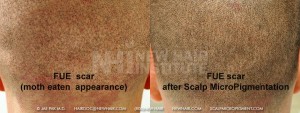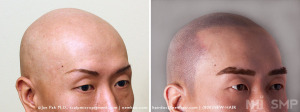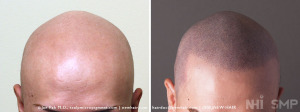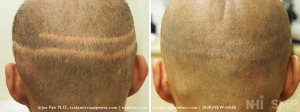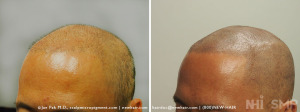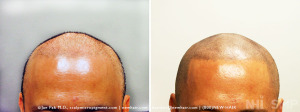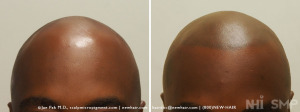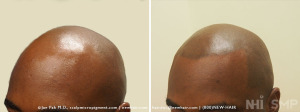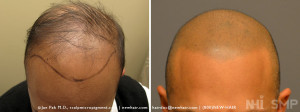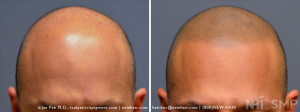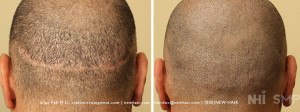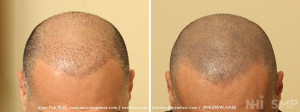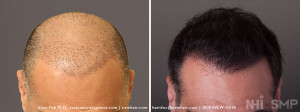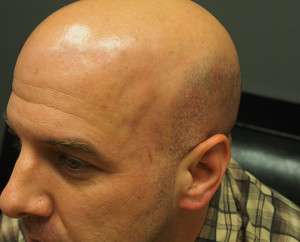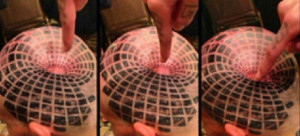This is a photo of a female patient who had a hair line lowering and rounding hair transplant surgery. This is sometimes known as forehead reduction surgery.
*CLICK TO ENLARGE PHOTO
This patient did not like her square high forehead with receded corners. She thought her hair line looked too masculine. She considered a forehead reduction surgery to lower the hair line. However, she was worried about the hair line incision scar. She also wanted the hair line corners to be more rounded in appearance which a forehead reduction surgery could not achieve.
FOREHEAD REDUCTION Surgery:
Forehead reduction surgery for women with a high forehead has been popular since the late 1990s. Dr Sheldon Kabaker in Oakland California is a well known and prominent surgeon who has been offering female forehead reduction surgery for many years. It sometimes requires the use of tissue expanders to drastically lower one’s hair line. Since 2006 Dr. Gal Aharonov in Beverly Hills California has been offering a slightly modified approach to the forehead reduction surgery. His method has gained great popularity from all over the world. With third party review sites such as RealSelf.com, the hair transplant community saw a demand for women seeking an alternative to forehead reduction. Potential problems of a forehead reduction surgery were the visibility of a scar along the hair line, and the limitations of creating an oval or rounded appearance. While patients were happy with the drastic reduction in their forehead size, some were self conscious about their scar and would not wear their hair pulled back. They addressed this with make up and sometimes a limited hair transplant procedure.
HAIR TRANSPLANT for hair line lowering:
An alternative for those women who did not want to undergo a forehead reduction surgery was a standard hair transplant procedure. Hair transplant procedure involves harvesting donor hair from the back of the head to individually relocate single follicles to the front. The limitations of a hair transplant procedure was that the results were not instantaneous. The transplanted hairs need to grow out from its roots. The advantage was a natural shaped hair line dictated by the artistry of the doctor creating the hair line. There was no scarring along the hair line.
The results for this hair line lowering patient were achieved using Follicular Unit Strip Surgery (strip surgery) sometimes referred as Follicular Unit Transplant (FUT). If Follicular Unit Extraction (FUE) method was used, it would have required shaving the back of the patient’s head. This is something few women would accept. There is no shaving involved with the strip surgery and the incision around the donor area (back of head) is covered by the patient’s hair. Even with the hair wet or hair up, the incision line (scar) will rarely, if ever be noticed. This incision may be an issue for men who keep their hair very short.
If the incision is an issue for a patient, the alternative method of harvesting hair is known as Follicular Unit Extraction (FUE). FUE harvesting is carried out manually by a highly trained surgeon or with an aid of the ARTAS robotic FUE instrument. There are other machines available such as Dr. Harris’s SAFE system or the NeoGraft machine you may have seen advertised in airline magazines. FUE method of donor hair harvesting may seem attractive for many patients because it is heavily marketed and advertised as a “no scar” surgery. This is NOT an accurate statement and is shunned by doctors since FUE does leave thousands of permanent round scars. Many patients have their FUE scars as well as strip scars camouflaged with Scalp MicroPigmentation.
This reinforces the fact that the latest technology and fancy robots are not always the best choice. For most women, a small linear scar on the back of their head may be a better option than shaving their head for thousands of FUE “dot” scars. Think of a C-section scar under long hair vs a moth eaten appearance on the back of a shaved head.



